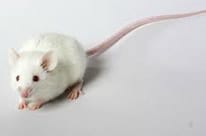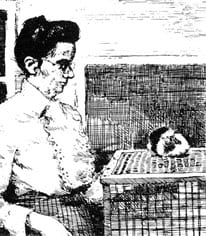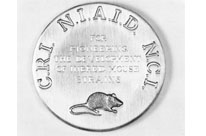To study cancer, researchers need a model organism—an animal similar enough to humans to be able to extrapolate lessons, yet simpler to work with. For the entire history of cancer research, that animal has been the lab mouse. Once referred to as “test tubes with tails,” lab mice are commonly the first stop on the road to cancer drug development.
 Lab mice differ in important ways from the common house mouse (mus musculus) that humans have lived with for centuries. For one thing, lab mice are essentially genetic clones of each other—the product of generations of careful inbreeding. This genetic identity allows researchers to be able to separate the influence of genes from environment—say, the cancer-causing effects of a particular chemical.
Lab mice differ in important ways from the common house mouse (mus musculus) that humans have lived with for centuries. For one thing, lab mice are essentially genetic clones of each other—the product of generations of careful inbreeding. This genetic identity allows researchers to be able to separate the influence of genes from environment—say, the cancer-causing effects of a particular chemical.
Today, researchers can order up a batch of lab mice of any strain by simply placing an order online. It didn’t use to be this easy. How lab mice came to be is a story that stretches back more than a century. By a quirk of history, the late William B. Coley—considered the father of immunotherapy, and the grandfather of the Cancer Research Institute—played a largely unrecognized role in supporting the development of this invaluable tool.

Mouse Fanciers
Mice have long been objects of fascination for humans, especially in East Asian countries where they were prized for their distinct color varieties and unique behaviors, such as a circular movement described as “waltzing.” For many centuries, the Chinese government kept records of albino mice found in the wild. In Japan, the mouse was regarded as a messenger of the God of Wealth, and is a common subject of Japanese woodcuts. Several varieties of such mice were preserved by mouse fanciers in the 19th century who bred them as a hobby.
One particularly important mouse fancier was a woman named Abbie Lathrop, from Granby, Massachusetts. Known by contemporaries as the “Mouse Woman of Granby,” Lathrop bred fancy mice on her farm and sold them to other fanciers. In 1908, she noticed that some of her mice had developed tumors. She sent these mice to a cancer researcher at the University of Pennsylvania, Leo Loeb, who confirmed the presence of cancer. Thus began the use of mice in cancer research.
Together, in a series of careful scientific experiments conducted between 1908 and 1919, Loeb and Lathrop showed that different strains of mice had different propensities for developing cancer (typically mammary cancer), and that cancer risk seemed to run in families of mice. This research provided the first evidence that cancer was a genetic, as opposed to an infectious, disease (a popular idea at the time).
Gregor Mendel’s work on pea plants, which established the basic rules of genetics, was rediscovered in 1900. Biologists were eager to apply this new understanding to cancer. Was cancer inherited in a simple dominant and recessive pattern as was flower color and fur coat color?
Scientists quickly realized that to understand the genetics of cancer, they would need the equivalent of Mendel’s “true-breeding” pea plants—animals from whom all genetic diversity was removed so that crosses between two different strains could be meaningfully interpreted.
The scientist credited with being the first to make this aspiration a reality was Clarence Cook Little, then a graduate student at Harvard. By carefully mating brother and sister mice, which he obtained from Abbie Lathrop, Little produced what became the first inbred strain of mice, called DBA (for dilute, brown, non-agouti).
 Not long after he created this strain, Little’s population of mice suffered an untimely end: typhoid fever tore through his colony, killing all the mice. Luckily, another scientist was at this time also becoming interested in inbred mice, a man named Halsey Bagg, at Memorial Hospital in New York.
Not long after he created this strain, Little’s population of mice suffered an untimely end: typhoid fever tore through his colony, killing all the mice. Luckily, another scientist was at this time also becoming interested in inbred mice, a man named Halsey Bagg, at Memorial Hospital in New York.
From a mouse dealer in Ohio, Bagg had obtained some albino mice in 1913, for use in animal behavior experiments. In order to produce genetically similar specimens, he began the process of carefully inbreeding his albino mice. He soon noticed that some of his white mice developed cancers. Not only that, but they did so at a predictable frequency. A mouse strain with a known propensity to develop cancer was a great boon to researchers interested in studying the disease. According to one account, a mouse with a spontaneous tumor went for $300 in 1919—equivalent to about $4,200 today. Bagg’s mice quickly caught the attention of other researchers in the field, who solicited him for animals.
Making Mice
One person who asked for Bagg’s mice was Leonell Strong, a graduate student in Thomas Hunt Morgan’s lab at Columbia University. Strong was interested in studying the genetics of cancer, which ran in his own family. Strong had been intending to use Little’s DBA mice for his experiments, but when Little’s colony was decimated by infection, he was forced to look elsewhere. Luckily, Bagg had done his graduate work at Columbia as well and Strong knew of Bagg’s interest in mice.
In 1920, Strong mated one of Bagg’s female albino mice to one of Little’s male albinos. The hardiest offspring were then chosen to be mated again, and again, for numerous generations. Gradually genetic variation was eliminated, and Strong created what became known as Strain A, which has a high incidence of lung cancer. Soon thereafter, by chance, some DBA mice that Little had given to another researcher were discovered and re-acquired by Strong; by mating one of the new Strain A mice with a DBA mouse from this stock, and repeating the inbreeding process, Strong created what became known as the C3H strain, another high-tumor strain. As Strong recalled in 1978, “the C3H is the most cancerous mouse in existence… every female developed cancer of the mammary gland at approximately six months of age.” Another researcher, E.C. MacDowell at Cold Spring Harbor, used Bagg’s albinos to create a third inbred strain of mice, called BALB/c (short for Bagg albino), in 1922.
Halsey Bagg would not have been able to conduct his research on albino mice—or share his mice with others—were it not for the financial support provided by the Collis P. Huntington Fund for Cancer Research, the first fund devoted to cancer research in the U.S. The fund was created in 1902 with money donated from Arabella Huntington to Memorial Hospital at the urging of William Coley, who served on its board. Coley was a family friend, and also served as Arabella’s personal physician. Arabella’s gift was $100,000, equivalent to roughly $2.8 million today. (Coley’s role in medical philanthropy is a subject of the forthcoming biography of the scientist, to be published by the Cancer Research Institute.)
Originally, the fund was established specifically to support the work that Coley was doing with mixed bacterial toxins to treat cancer. But gradually it took on other funding priorities.
Bagg became a fellow of the fund in 1917, working primarily on the effects of radiation on heredity, in collaboration with C. C. Little at Cold Spring Harbor. A few years later, by way of Strong, Bagg’s mice were being use to replenish and extend Little’s increasingly large supply of inbred mice.
It was out of this research program that some seminal discoveries in immunology and cancer were made. The major histocompatibility (MHC) locus, for example, was discovered in the 1940s by George Snell and Peter Gorer at Jackson labs.
The Mouse Factory
To further his interests in mouse genetics, Little used his connections to wealthy patrons to fund the creation of a new laboratory devoted to this topic. The Roscoe B. Jackson laboratory, in Bar Harbor, ME, opened in 1929. That same year, the stock market crashed, and funding for the fledgling institution dried up. Ever the entrepreneur, Little took advantage of the newfound standing of mice as an experimental research tool to convert the Jackson lab from a primarily research organization into one devoted to producing mice for other labs. By 1941, The Jackson Lab was shipping some 2,500 mice per week to researchers around the country. (Today, JAX® mice are a standard research tool in modern cancer research. More than 3 million JAX mice are shipped to researchers around the world each year.)
Proceeds from mice sales kept the small research program of the lab afloat. It was out of this research program that some seminal discoveries in immunology and cancer were made. The major histocompatibility (MHC) locus, for example, was discovered in the 1940s by George Snell and Peter Gorer at Jackson labs.
Though Little was clearly the genius behind the creation of inbred mice, he would not have been able to create some of the most valuable strains for cancer research without the contributions of Halsey Bagg—and indirectly, those of William Coley.
It is hard to overestimate the importance of the Bagg-related strains of mice, as even a cursory jaunt through the history of cancer research attests:
- John Bittner’s discovery, in 1936, of a cancer-causing “milk factor,” now known to be a virus: strain A and CBA mice.
- Murray Shear’s studies of chemical carcinogens: strain A mice.
- Wynder, Graham, and Croninger’s famous 1953 tobacco tar experiments, which proved that tobacco could cause cancer: strain A crossed with BALB/c mice.
- Edward Foley’s tumor transplantation experiments which put tumor immunology on the map: C3H mice.
- Lloyd Old’s discovery of tumor necrosis factor (TNF): BALB/c mice.
- Kohler and Milstein’s development of the hybridoma technology to make monoclonal antibodies: BALB/c mice.
 To acknowledge and honor the achievement of those researchers responsible for creating inbred mice, the Cancer Research Institute in 1978 co-sponsored a conference on this topic, along with the National Cancer Institute (NCI) and the National Institute of Allergy and Infectious Disease (NIAID). The conference was introduced by CRI founder Helen Coley Nauts, and the papers delivered were eventually collected and published as a book, which is today a standard reference work on inbred mice. That same year, at its annual awards dinner, CRI honored seven scientists for their contributions to mouse research, including Little, Strong, and Snell.
To acknowledge and honor the achievement of those researchers responsible for creating inbred mice, the Cancer Research Institute in 1978 co-sponsored a conference on this topic, along with the National Cancer Institute (NCI) and the National Institute of Allergy and Infectious Disease (NIAID). The conference was introduced by CRI founder Helen Coley Nauts, and the papers delivered were eventually collected and published as a book, which is today a standard reference work on inbred mice. That same year, at its annual awards dinner, CRI honored seven scientists for their contributions to mouse research, including Little, Strong, and Snell.
Ironically, Halsey Bagg himself was not among those honored that evening. Nevertheless, Bagg’s contributions live on in the many strains of inbred mice, related to his own, that are still in use today.
For more on the history of inbred mice, see the fascinating book Making Mice by Karen Rader.
